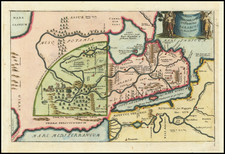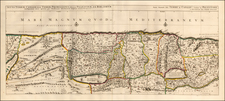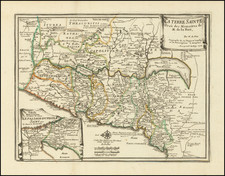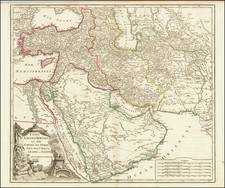Scarce map of Antioch, Syria from the reduced size example of the Nuremberg Chronicle.
A reduced size version of the book was published in 1496 in Augsburg by Johann Schonsperger, with a Latin edition published in February 1497. These smaller versions are much rarer than the original folio sized edition.
This miniature edition is much rarer than the larger editions.
The Liber Chronicarum, or Nuremberg Chronicle, is a universal history, with a strong emphasis on geography, also known as a cosmography. The work was published by Anton Koberger on a commission from the merchants Sebald Schreyer and Sebastian Kammermeister. At this time Koberger, the second printer to set up shop in Nuremberg, was at the height of his business, with as many as eighteen presses at work.
For the compilation of the Latin text, which was translated into the vernacular by George Alt, Schedel called on Medieval and Renaissance writers including Bede, Vincent of Beauvais, Martin of Tropau, Flavio Biondo, Bartolomeo Platina, Aeneas Piccolomini, and Jacobus Philippus Foresti de Bergamo. Schedel split the book into parts: Creation, the ages of Adam, Noah, Abraham, and David, the Babylonian Captivity, the life of Christ, the Antichrist, and Judgement Day, followed by a text on Poland, on Europe, and all with a final note on how the book was made. The work contains 1,804 woodcut images executed from 641-3 woodblocks by Michael Wohlgemut (1434-1519) and his stepson Wilhelm Pleydenwurff (1460-1494). Interestingly, Albrecht Durer had worked and learned in the Wohlgemut shop in the late 1480s and Koberger was his godfather.
The Chronicle appeared in 1493, with the first print run taking place between March 16, 1492 and June 12, 1493, for the Latin edition, and to December 23, 1493, for the German translation. A reduced-size (quarto) version of the book, with new illustrations, was published in several editions by Johann Schonsperger, in Augsburg, between 1496 and 1500.
The encyclopedic book includes many portraits and illustrated scenes, including the famous Dance of Death. The geographic content of the Chronicle is also notable. In addition to the double-page Ptolemaic world map and a map of Northern Europe, there are large format views of many cities including Rome, Venice, Paris, Vienna, Florence, Genoa, Salzburg, Krakow, Breslau, Budapest, Prague, Jerusalem, Alexandria, Constantinople, as well as a number of towns in what would become the German Empire.









![A view of the division of the land of Canaan and the situation of the city and sanctuary [Manuscript map]](https://storage.googleapis.com/raremaps/img/small/87556.jpg)



![Terra Sancta sive Palaestina exhibens non solum Regna Vetera Iuda et Israel in Suas XII Tribus Distincta . . . 1759 [The Holy Land, or Palestine, displaying not only the ancient kingdoms of Judah and Israel divided into their Twelve Tribes... 1759]](https://storage.googleapis.com/raremaps/img/small/90182.jpg)
